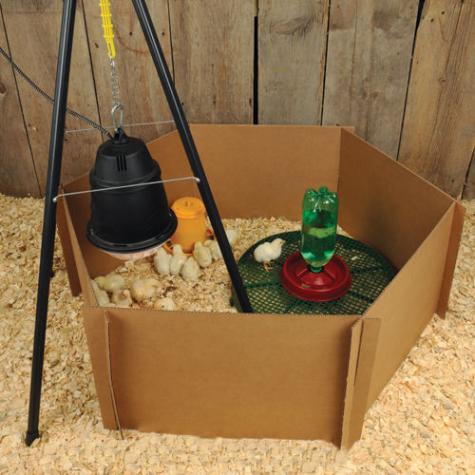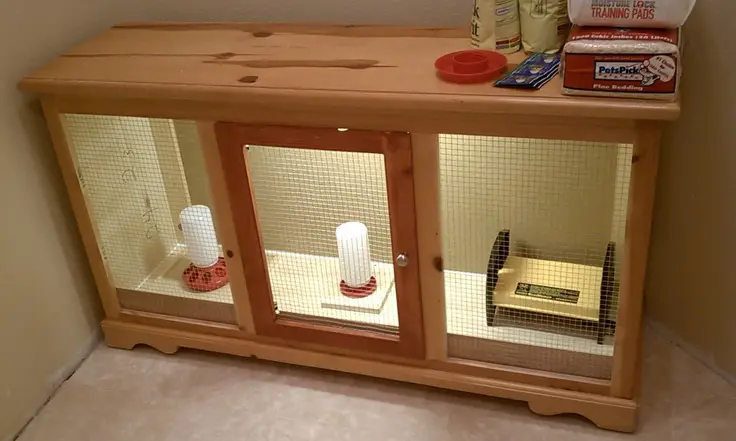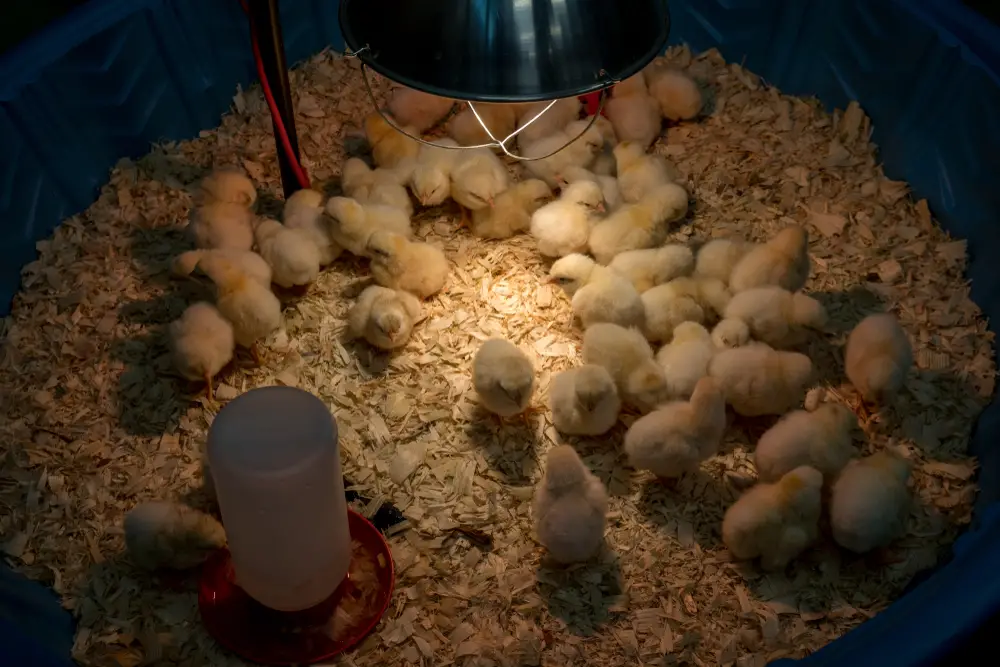Building your own DIY chicken brooder is a fun and affordable project to take on before you start your journey with raising chicks. There are many unique plans available with designs that can be built within just 2 hours.
The following list consists of 7 simple chick brooder ideas that will help you design the ideal brooder for your homesteading needs.
Table of Contents
Easy Chicken Brooder Ideas
1. Simple Panel Brooder

Building a chick brooder can be intimidating, so why not pick the simplest option?
Panel brooders (collapsable brooders) are simple and efficient ways of raising baby chicks. This brooder setup is quick, simple, and cost-effective.
Essentially you will use interlocking boards that simply slide into one another to create a square or hexagonal brooder. You can also use additional fasteners such as screws or zip ties to make sure that your panels will stay together. Then simply add your bedding, heat lamp, and other essentials and you’re done!
Not only is this probably the easiest form of creating your own DIY chick brooder, but it can also be the cheapest. While you can use panels made of wood or plastic, you can also use panels made out of old cardboard boxes. Any sort of material that will function as a wall should work just fine in a panel brooder.
Even though this isn’t the flashiest brooder, many chicken keepers have seen plenty of success when using a simple panel brooder. Because it’s so easy to put up and take down, you can conserve space in your yard when you’re not raising baby chicks.
2. Repurposed Furniture Brooder

Do you have an old dresser or entertainment center kept in storage somewhere? Then look no further, you’ve just found your chicken brooder!
Repurposing old furniture as a brooder is a recent trend in chicken keeping that is surprisingly effective. Most wooden furniture will be big enough to support a small batch of chicks to raise.
Simply remove any drawers and dividers within your cabinet, and seal off any openings in the doors with chicken wire or thin wire mesh. Not only will your repurposed brooder function perfectly, it will also be totally unique and add a personal touch to your chicken-raising experience.
3. Kiddie Pool Brooder
Kiddie Pool Brooders are surprisingly common in the world of raising chickens. Not only are they easily accessible and cheap, but they also take very little effort to set up.
Most kiddie pool brooders will use one pool as a base, fence off the sides with sheets of thin metal and chicken wire, and then use a second pool as a makeshift lid. A perfectly closed atmosphere that will keep your chicks safe and warm.
Also, if you want to bring your brooder outside for your chicks to get some sunlight, it is easy enough to remove the cover of the second pool.
4. Easy Storage Bin Brooder
This is another simple but effective way to build a brooder. If you have any plastic storage bins lying around, they are usually a similar size and shape of a commercial mini brooder.
Simply cut a hole in the lid to allow heat and light to come in, set your bedding and you’re good to go! A small storage bin makes for a brooder box that’s easy to move around in the chicken coop when necessary.
One way of upgrading this setup would be to construct some sort of mesh fencing to cover the opening that has been cut in the storage bin lid. This will function as a safety measure to prevent your heat lamp from falling directly into the brooder.
5. DIY Wooden Brooder
This is another basic model brooder that allows you a lot of room for creativity. A wooden brooder usually consists of sheets of plywood, repurposed wooden pallets, 2x4s, and metal hardware cloth.
Being made out of such basic construction materials grants you a lot of flexibility when drawing up the blueprint. While you can follow step-by-step chicken brooder plans online, you can also make adjustments to certain sizes to make your brooder fit perfectly in the coop.
If you are confident using a saw and a hammer, then building a wooden brooder from scratch will be incredibly rewarding. The finished product will also feel much more permanent than other brooders, such as the one made out of a kiddie pool, and will last for years to come.
6. Multi-Leveled Brooder
If you’re planning on raising a large flock all at once, then a multi-leveled brooder is going to be your best option. These are highly common in the poultry industry because they are so effective at raising many chicks at the same time.
In theory, you can add as many layers to a multi-leveled brooder that you need. Just make sure you’re able to properly access the upper layers, as you will need to make sure that they stay clean. Having your the “top floor” grow damp with spilled water and chick poop could encourage bacteria to spread to the lower floors of the brooder.
7. Outdoors Brooder
Outdoor chicken brooders are great for allowing your chicks to quickly grow acclimated to being outside. Not only will they get lots of fresh air and sunlight, but they will also learn how to forage from a young age. Outdoor brooders will often be portable as chicken tractors, allowing your new chickens to forage throughout your yard
You will construct an outdoors brooder very similarly to a wooden brooder, though you’ll want to have some sort of roof in case of rain. A simple, slanted roof made out of plastic or metal is usually your best bet.
Safety and Bedding
With any of these approaches to building a chicken brooder box, it’s most important to consider safety and sanitation. The biggest safety precaution for any brooder usually has to do with the heat lamp. Heat lamps need to constantly be on in order to keep your chicks warm but can also become a dangerous fire hazard.
When using a traditional heat lamp, you will want to make sure it is at least 12 inches above the bedding in the brooder. Once it’s safely secured away from the bedding, it is usually best to enclose the top of the brooder with a metal fencing material in case the lamp were to fall.
Beyond being a fire hazard underneath a heat lamp, bedding in a brooder can also be a breeding ground for parasites and bacteria. If not regularly cleaned and rotated, soiled bedding can prevent serious health risks to baby chicks.
One of the best methods of setting up bedding is to use a soft rubber mat that is covered in wood shavings. Pine shavings will absorb moisture from spilled water and droppings while providing soft footing for your chicks’ tender feet. When the shavings are too damp and dirty, simply sweep them off of the rubber mat and replace them with new shavings.
FAQs
How Long Can Chickens Stay in a Brooder?
Figuring out when your chicks are ready to leave the brooder is usually dependent on when they start to get their adult feathering. As a rule of thumb, most chicks can start to go outside at around 6 weeks after hatching, and then be fully introduced to your outdoor flock at around 10 to 12 weeks of age.
You also want to make sure that the outdoor temperatures are at least 70 degrees Fahrenheit before letting them out. This will make sure that they can easily keep their body temperatures high enough to survive. While a 60-degree day might not feel that much colder, your chickens will have to exert a lot more energy to stay warm.
What Should I Do If My Brooder Gets Too Hot?
If the temperature in your brooder starts to exceed 100 degrees Fahrenheit, then you’ll need to make some changes. The easiest method is to move your heat source further away from the brooder.
Basic heat lamps that are hanging or are clamped to the side of your brooder can be raised and refastened away from your brooder. Make sure to make these changes in small increments, as you don’t want your brooder to grow too cold for your little chicks.
Move your lamp up just an inch or two, and then evaluate the temperature after an hour or so. Repeat this process until your brooder is at the proper temperature.
Can I Keep My Brooder Outside?
Yes, you can definitely keep your brooder outside. As long as your brooder is properly weathertight and maintains the right temperature, your chicks should be just fine.
Of course, outdoor brooders run the risk of being more vulnerable to predators, so always make sure your brooder is well built and there aren’t any easy entry points.
Outdoor brooders can also be greatly affected by humidity. The last thing you want is your chicks to be living in damp bedding which is prone to growing bacteria. Regularly cleaning out bedding will reduce the likelihood of bacteria growth.

